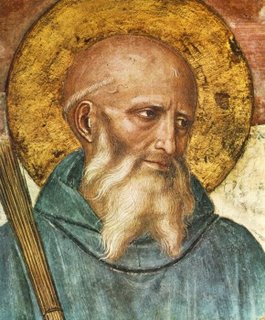Faith Seeking Understanding for July 9, 2006
 This week, on July 11th, the Church celebrates the memorial of St. Benedict, the great father of western monasticism. Nearly all that we know about Benedict’s life comes from St. Gregory the Great (himself a Benedictine monk) and his writings. Benedict was born in modern-day Norcia, Italy, (about
This week, on July 11th, the Church celebrates the memorial of St. Benedict, the great father of western monasticism. Nearly all that we know about Benedict’s life comes from St. Gregory the Great (himself a Benedictine monk) and his writings. Benedict was born in modern-day Norcia, Italy, (about After departing Rome with several companions, he took up residence in a town near Subiaco, in an effort to find some peace to discern his next step in radically following Christ. He soon met a monk, Romanus, who gave him a monastic habit and encouraged him to live as a hermit. During the next three years, he remained in a nearby cave, growing in self-discipline and holiness. He gradually gained great fame, and when the abbot of the monastery died, he was prevailed upon by all to take up the task.
Unfortunately, however, the monks were not used to Benedict’s austerities and discipline, and tried to poison him. He survived, and his fame for holiness continued to grow and many came to Subiaco for training in the monastic life, and sought to be subject to Benedict under the vow of obedience. In response, twelve monasteries were built, in which these new monks lived, always looking to Benedict as their father and head.
During this period of Benedict’s life, he forged the practice of monasticism to be the perfect balance of “ora et labora” – “prayer and work”. The monks lived a communal life, working together and praying together, striving as a family to live the fullness of the evangelical counsels of poverty, chastity, and obedience. As the monasteries grew, however, troubles came to Subiaco; in order to preserve the monks, Benedict moved the foundation to the hilltop of Monte Cassino, which become the great center of the Benedictine life for centuries.
It was here at Monte Cassino that Benedict wrote his famous “Rule,” known throughout the world as the foundation document for Western monastic life. The Rule of St. Benedict describes in detail the entire life of the monk: his prayer, his work, his meals, his rest, and his interior dispositions. The Rule has been the source of inspiration for generations and generations of Benedictine monks, and remains a central part of monastic life today. Many monasteries read a section of the Rule before every evening meal.
One of Benedict’s great accomplishments was to achieve a balance in prayer and work; the austerities were not severe, and the penances not burdensome. The goal of the monastic life coincides with the Christian life: to establish a community with Christ at its center. A unique and distinctive feature of the Benedictine life, however, is the continual chanting of the Psalms.
Known as the Divine Office (or Liturgy of the Hours), the monastic practice of singing the Psalms throughout the day organizes the life of the monastery. The monks assemble to sanctify the hours by chanting the mercies of God. Most of the entire repertoire of Gregorian Chant comes from the monastic Office. Nothing captures the medieval imagination quite like an ancient monastery, with black-robed monks silently processing into their choir-stalls, prepared to offer the “Sacrifice of Praise” on behalf of the entire world.
St. Benedict died at Monte Cassino sometime around A.D. 543. Since then, the Benedictine monks have been responsible for evangelizing Europe and preserving the faith during the darkest times; they have become popes and cardinals; and continue today to witness the need for holiness and sacrifice in the modern world.
St. Benedict, pray for us

<< Home